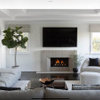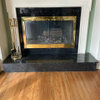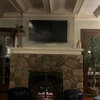Homemeade Hearth
chapru
17 years ago
Sponsored
Columbus Area's Luxury Design Build Firm | 17x Best of Houzz Winner!
More Discussions
Two years ago, I built a homemade hearth pad for my Harmon P-68. It works very well. Now I want to build one for my cottage, but I'm not sure if I want a wood or pellet stove.
My idea is laying four, 4"x4" pressure treated posts on the concrete slab with a 4'x4'piece of 3/4" plywood screwed on top of the posts( forming a 4'x4' pad). On top of the plywood would be a 1/2" concrete backer board (Durarock). I would then place two layers of 2'x2' flat stones, 1 inch thick, on top of that, for a total stone thickness of 2 1/2".
I know that the above would handle the heat from a pellet stove, but would it be enough to handle the heat from a wood stove?
Any ideas or suggestions? Thanks in advance.




ventupete
chapruOriginal Author
ventupete
chapruOriginal Author
ventupete
chapruOriginal Author
ventupete
chapruOriginal Author